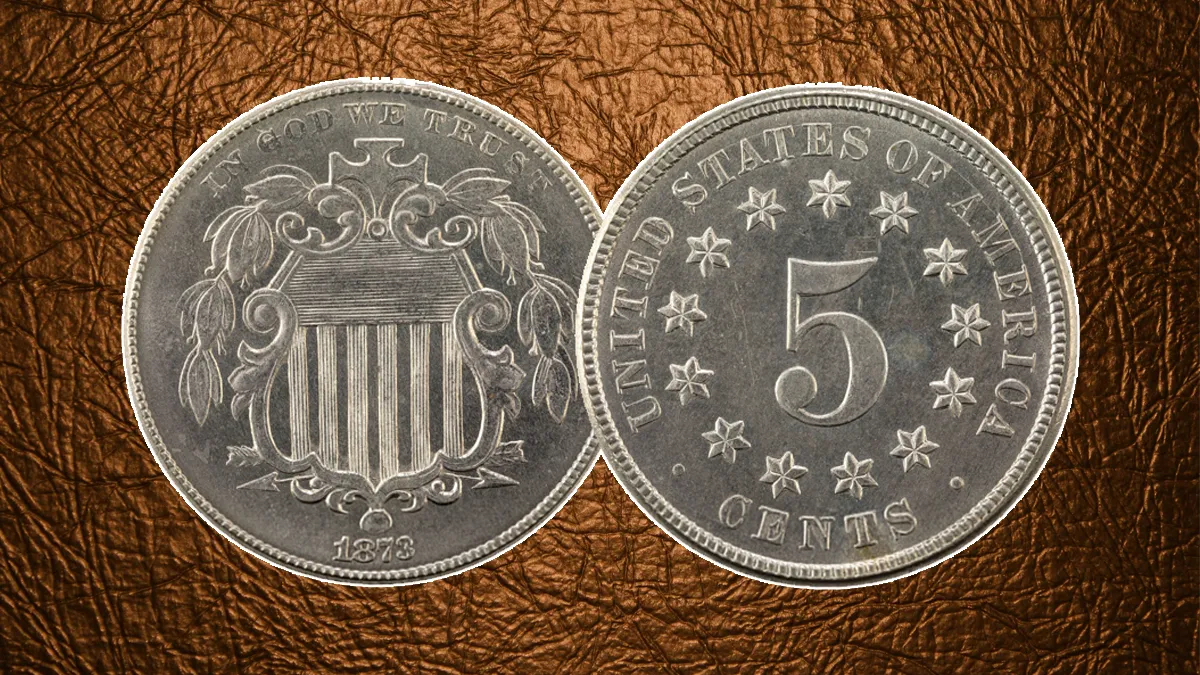
If you are new or a novice to collecting antique coins, it may be very challenging to choose the most valuable nickels and coins depending on the current market in rare collectible coins.
There are different types of Most Valuable Nickel Error Coins Worth Money and their value can be high because of rarity, condition, or history.
A Brief History of Nickels
The history of the nickel traces back to the American Civil War in 1861 when widespread panic led to a shortage of coins, including precious metals like gold and silver. In 1866, President Andrew Johnson approved the coinage of five-cent pieces made of nickel and copper, leading to the creation of the Shield nickel adorned with a shield, a prominent “5,” and the words “In God We Trust.” This coin was produced until 1883.
Subsequent designs emerged, including the Liberty Head nickel due to manufacturing issues with the Shield nickel. In 1913, the Buffalo nickel was introduced, followed by the first Jefferson nickel in 1938.
The nickel underwent various design updates, with the most recent in 2006 changing President Jefferson’s image from a profile to a frontal portrait. Coin-operated machines like vending machines and jukeboxes further cemented the nickel’s importance in daily transactions.
Types of Nickels
Shield Nickel Series (1866–1883):
- Key dates: 1877, 1878, 1879, 1880, 1881
- Produced only at the Philadelphia Mint, Shield nickels have no mintmark, making a complete date set consisting of sixteen coins. Rare-dated versions can hold significant value, with prices starting around $18 for common dates and climbing to over $1,000 for 1879 or 1880 Shield nickels depending on condition.
Liberty Head Series (1883–1912):
- Key dates: 1885, 1886, 1912-S
- Known as the “V” nickel, Liberty Head nickels faced production errors and scandals. The addition of the word “cents” to the reverse design created two varieties in the first year of production.
- Exceptionally rare 1913 Liberty Head nickels, with only five known to exist, are valued in the millions. Depending on scarcity and date, a V Nickel’s value ranges from $10 for an 1889 in good condition to over $1,500 for an 1885 in uncirculated condition.
Buffalo Nickel Series (1913):
- Key dates: 1913-S Variety 2
- Minted for 25 years, Buffalo nickels feature iconic American imagery. Those in outstanding condition are more valuable, with key dates including the 1915-S from San Francisco, the 1913-S Type 2 with a distinct line under the reverse artwork, and the 1918/7-D with a visible “8 over 7” overdate.
Jefferson Nickel Series (1938):
- Key dates: 1938-D, 1939-D, 1939-S, 1950-D
- The longest-running nickel series features Thomas Jefferson’s portrait and remained relatively unchanged for over six decades. While earlier dates can still be found in circulation, assembling a set of gem-condition coins with well-defined strikes poses a challenge for collectors.
List Of 10 Most Valuable Nickel Error Coins Worth Money
1. 1867 Shield Nickel
In 1867 Shield Nickels, the rays were removed, but some still have them around the five. Around 10 of these exist, with one selling for $132,250 in 2004 through Heritage Auctions.
2. 1913 Liberty Head V Nickel
The 1913 Liberty Head V Nickel was replaced by the Buffalo Nickel design that year. However, for unknown reasons, five nickels were minted with the old Liberty Head design. Out of these five rare coins, three are in private hands. In 2018, one of these sold through Stack’s Bowers Galleries for $4,560,000 ($5,262,000 value in 2023).
3. 1913 D Buffalo Nickel – Type 2
In 1913, the nickel changed from the Liberty Head V to the Buffalo design. Two types of Buffalo designs emerged. The first read Five Cents, while Type 2 models had this removed. One Type 2 Buffalo Nickel sold for $143,750 in 2008 through Bowers & Merena (now Stack’s Bowers Galleries).
4. 1916 Buffalo Nickel – Double-Dyed Obverse
The 1916 rare Buffalo nickels have double dye, especially noticeable on the date and Chief’s chin. Only 200 known exist, one of which sold for $281,750 in 2004 through Bowers & Merena (now Stack’s Bowers Galleries).
5. 1917 S Buffalo Nickel
The 1917 S Buffalo Nickel from the San Francisco Mint exhibits an unusual dye quality, contributing to its rarity. One of these nickels sold for $138,000 in 2008 through Heritage Auctions.
6. 1918/7-D Buffalo Nickel – Doubled Die Obverse
The 1918/7-D Buffalo Nickel has a unique overdate, with seven appearing under the eight. This mistake wasn’t noticed until the 1930s. Genuine coins have a mintmark tilted to the left. In 2006, one sold for $350,750 through Bowers & Merena (now Stack’s Bowers Galleries).
7. 1918 S Buffalo Nickel
The 1918 S Buffalo Nickel is rare due to flaws, with most not well-struck. It was also produced in low quantity. One sold for $125,350 in 2008 through Bowers & Merena (now Stack’s Bowers Galleries).
8. 1920 D Buffalo Nickel
Of the 9.5 million Buffalo Nickels minted by the Denver Mint in 1920, only a few top-quality examples exist. One high-grade example sold for $138,000 in 2008 through Bowers & Merena (now Stack’s Bowers Galleries)
9. 1926 S Buffalo Nickel
The 1926 S Buffalo Nickel is rare because only 970,000 were minted by San Francisco, compared to millions from other mints in other years. In 2008, one sold for $322,000 through Bowers & Merena (now Stack’s Bowers Galleries).
10. 1927 S Buffalo Nickel
Most of the 1927 S Buffalo Nickels have striking flaws, making pristine examples rare. One sold for $48,875 in 2012 through Bowers & Merena (now Stack’s Bowers Galleries).
Some Key Factors in Determining the Value of Your Rare Coins
To determine the value of rare coins, collectors should check them closely using a magnifying glass. The main Key factors in determining the value of your rare coins are the coin’s condition and mintmarks. Here are some guidelines to help you evaluate the condition of coins:
- Poor (PO-1): Coins are hardly recognizable, with large parts of the design missing.
- Fair (FR-2): The date should be visual, but lettering may be worn.
- About Good (AG-3): Most design is outlined, but edges may have worn into the lettering.
- Good (G-4, 6): The design is outlined, but some features are weak due to wear.
- Fine (F-12, 15): All letters of “LIBERTY” should be visible with little wear.
- Very Fine (VF-20, 25, 30, 35): General details are visible with medium to light wear.
- Extremely Fine (XF-40, 45): Light wear with traces of mint luster.
- About Uncirculated (AU-50, 53, 55, 58): Extremely light wear with minimal friction.
These grades provide a general idea of a coin’s condition, but standards can vary by type and date.
Mintmarks and Rarity
Jefferson’s nickels with a “D” mintmark indicate they were minted in Denver. Mintmarks are crucial for identifying coins from different United States Mint facilities, greatly affecting their value. Coins without a mintmark were likely minted in Philadelphia. Here are common mintmarks:
- C: Charlotte (Gold, 1838–1861)
- CC: Carson City (1870–1893)
- D: Dahlonega, Georgia (Gold, 1838–1861)
- D: Denver (1906 to date)
- O: New Orleans (1838–1909)
- P: Philadelphia
- S: San Francisco (1954 to date)
- W: West Point (1983 to date)
- Mintmarks can significantly impact a coin’s value, especially if they coincide with rare dates. For instance, a 1939 Jefferson nickel with a “D” mintmark can be much more valuable. Additionally, Jefferson nickels minted between 1942 and 1945 with large “P,” “D,” or “S” mintmarks contain silver and are increasing in price. Today, coin collecting is a popular hobby, with new issues saved and many coins available in attractive, uncirculated grades. Consulting an appraiser is recommended for determining the fair market value of rare nickels.
Also Read – Top 10 Most Valuable Indian Head Pennies Coins Worth Money
Conclusion:
Collectors are looking for a variety of expensive nickel error coins. These coins, which come from many series and years, are valuable because of their historical importance, rarity, and good condition. Knowing their value includes taking into account elements such as mintmarks, condition, and scarcity. Collecting collections of these rare nickels can provide collectors, whether how experts or novices with excitement and financial options.
